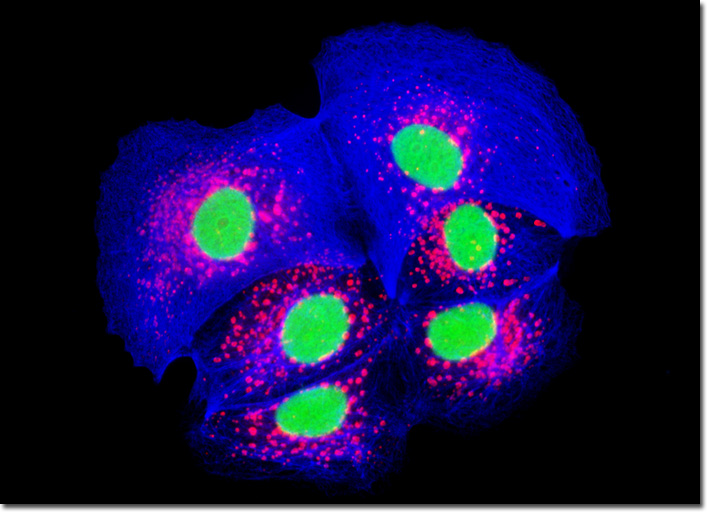Fluorescence Digital Image Gallery
Madin-Darby Canine Kidney Epithelial Cells (MDCK)
|
Keratins are a family of water-insoluble proteins that form monofilaments, which together comprise one of the primary classes of intermediate filaments in the epidermis and various other epithelial tissues. Typically in epithelial cells, keratin filaments are located throughout the entire cytoplasmic region. Along the cell periphery, the filaments interact with cell matrix and cell-to-cell adhesion complexes. Keratin filament networks function chiefly in the endowment of epithelial cells with the resilience to withstand the mechanical stress that they may incur incidentally. This fact is evidenced by inherited skin fragility disorders, which are linked to mutations in keratins. The adherent culture illustrated above was immunofluorescently labeled with mouse anti-cytokeratin (pan) primary antibodies, followed by goat anti-mouse secondary antibodies conjugated to Marina Blue. Mitochondria were visualized with MitoTracker Red CMXRos and the nuclei were stained with SYTOX Green. Note the prominent staining of the cytokeratin network throughout the cytoplasm in these cells. Images were recorded in grayscale with a QImaging Retiga Fast-EXi camera system coupled to an Olympus BX-51 microscope equipped with bandpass emission fluorescence filter optical blocks provided by Omega Optical. During the processing stage, individual image channels were pseudocolored with RGB values corresponding to each of the fluorophore emission spectral profiles. |
© 1995-2025 by Michael W. Davidson and The Florida State University. All Rights Reserved. No images, graphics, software, scripts, or applets may be reproduced or used in any manner without permission from the copyright holders. Use of this website means you agree to all of the Legal Terms and Conditions set forth by the owners.
This website is maintained by our
|
